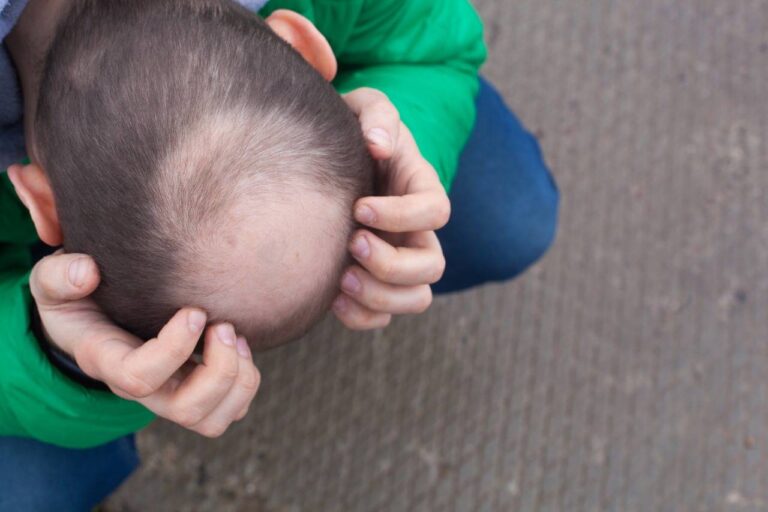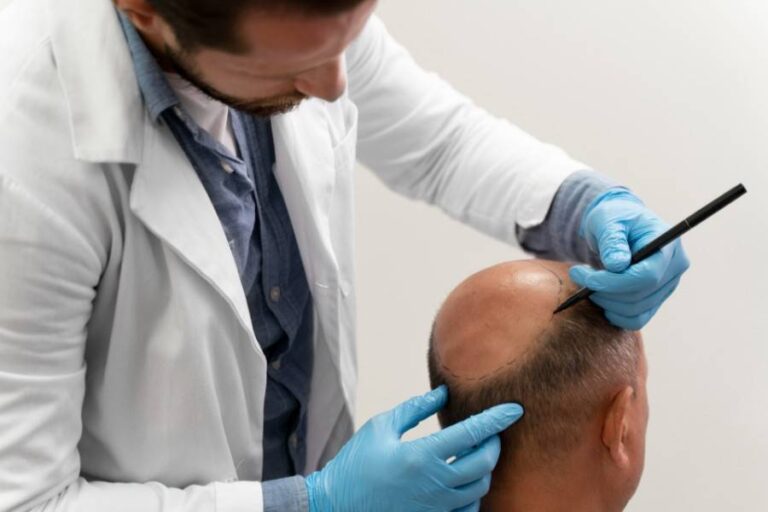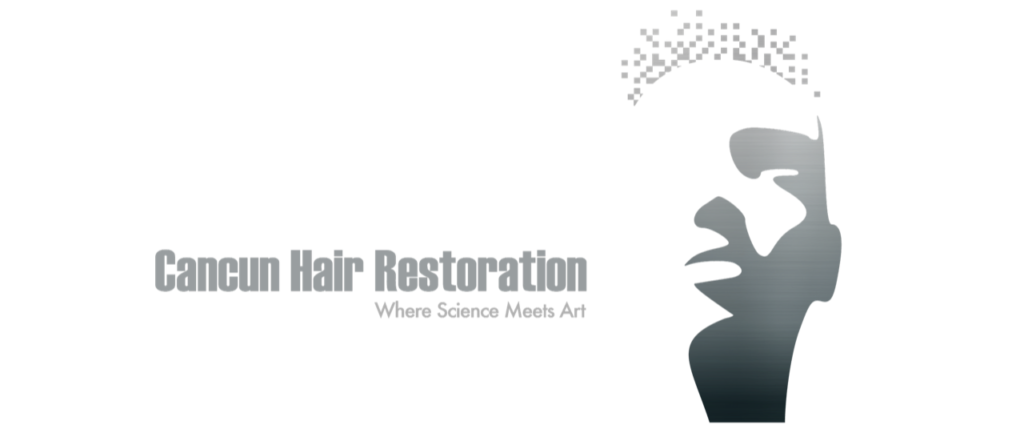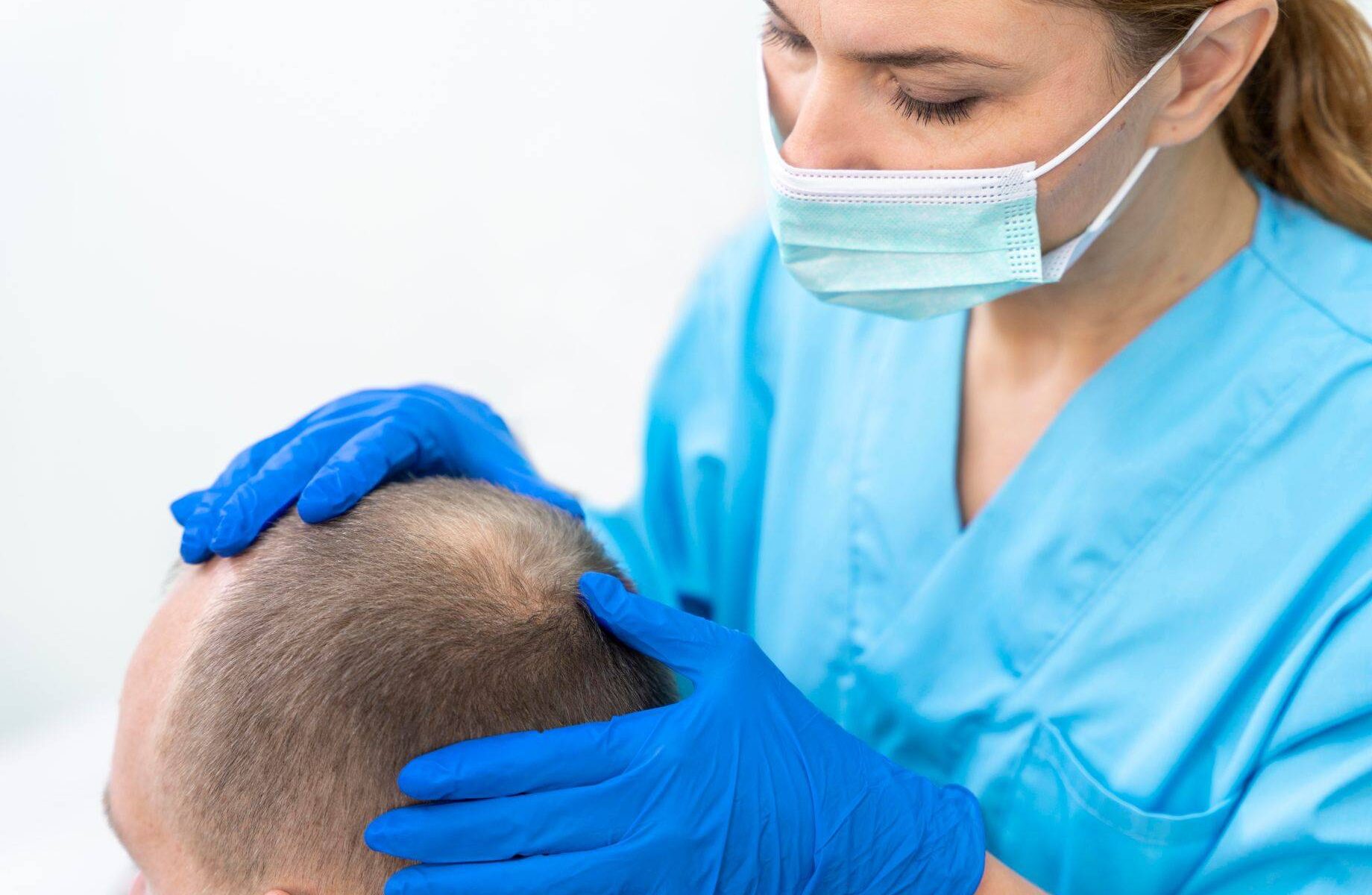Maybe you are already looking for a crown of head hair transplant, but still don’t know if the procedure will be successful for your type of hair loss. Crown of the head hair loss, accompanied by receding hair it’s a big issue, but you can definitely correct it with a hair transplant at Cancun Hair Restoration.
This is the most common type of baldness in men, but it’s a problem than can also occur in women. Thinning of the hair on the crown of head will eventually lead to baldness in this area, as well as other causes. But maybe you’ll be wondering if the hair transplant is it viable in this area for you?
To know if a hair transplant in this area of the head is viable, the first thing you have to know are the causes that cause hair loss in the crown of the head. Later, you’ll learn more about the procedure involved in a hair transplant and finally the feasibility of this operation.
CAUSES OF HAIR LOSS AT THE CROWN OF HEAD
In 95% of men’s cases, baldness on the crown of the head are due to genetics. In the case of women, it’s usually caused in part by a hormonal disorder and also by genetics, although hair loss is usually more dispersed than in men. Some of the causes of hair loss in the crown of head in this area are:
- Alopecia areata.
- Anagen hair loss.
- Scarring alopecia.
- Disorders of hair growth.
- Inflammatory scalp.
- Telogen hair loss.
- Traction alopecia.
- Trichotillomania.
Depending on the type of baldness and the progress of hair loss, drug treatment or surgical procedure may be considered. It’s important to note that a procedure like hair transplant in the crown of head must be performed by an expert to ensure safe and successful treatment.
THE BEST OPTION FOR CROWN OF HEAD HAIR RESTORATION
Having a hair transplant in the crown of the head is not a decision that should be made lightly and without information, so several factors need to be considered before getting one. You can ask our doctors at Cancun Hair Restoration, just leave us a message at our contact page and we’ll answer everything you want to know; but some of this factors includes:
- Degree of crown of head area hair loss.
- If there is a possibility that the scalp will self-regulate and hair loss will decrease naturally.
- The ability to create natural looking hair patterns in the crown area.
When you talk to a doctor about the possibility of having a hair transplant in the crown of the head, make sure to check all these factors. A procedure like this should be fully reviewed so that it is completely safe for you. So get rid of all the doubts you may have about it once and for all and get in touch with the hair restoration experts of CHR.
CROWN OF HEAD HAIR TRANSPLANT: THE PROCEDURE
To get the best results during crown hair transplant, technical skill and artistic vision are required to perform this procedure in order to give a natural appearance and texture, avoiding at all costs an artificial appearance.
This kind of procedure consists of extracting hair plugs from the donor area from the back of the scalp, using the method of follicular extraction units, also known as FUE hair transplant. The extracted follicles are placed precisely in the receiving area, which is the one that presents thinning hair or baldness.
Implants are performed under enlarged vision, so that the existing follicles are not damaged, resulting in hair fully distributed at perfect angles in the crown of head, direction, pattern and, in addition, with graft-to-site adjustment.
The procedures that will help you recover the hair on the crown of head that we have at Cancun Hair Restoration are 4. Each one consists of changing the hair follicles from an area where there is greater volume to the area where there is thinning and loss of hair. hair.
Previously, we told you a little about the FUE hair transplant technique that is usually used for hair restoration in the crown of the head. Therefore, below, we will provide a little more information about the procedure and we will tell you about the other 3 options that we offer you in our clinic:
- FUT hair transplant: The FUT hair transplant consists of removing a 20 cm strip of hair from the nape of the neck to obtain the largest number of hair follicles to place them on the crown of head. With this procedure, a large number of grafts are obtained and it is more used for severe cases of hair loss.
- FUE hair transplant: This procedure is one of the most required for hair loss on the crown of the head, especially when it is due to thinning hair. The surgeon will take care of removing all possible follicles, but without the need to remove a strip of hair as with the previous treatment.
- ARTAS hair transplant: This type of hair transplant is carried out with the help of the ARTAS robot, which is responsible for extracting the best hair follicles and tracing the ideal place on the crown of head to transplant them. This technology is state of the art in hair restoration and will provide the best possible results.
- DHI hair transplant: For this hair transplant, a special tool is required that allows the plastic surgeon to collect the hair follicles and place them on the crown of the head immediately. This procedure is very meticulous, but faster than any of the previous ones.
If you want to know more about the procedures we have for you to recover your hair from the crown of head, you can send us a message from our contact page with all your questions and we will answer them immediately.
CROWN OF HEAD HAIR TRANSPLANT: RECOVERY

The recovery process is generally the same to that of other of hair transplant in other parts, not just the crown of the head. That is, the patient usually recovers in just 24 hours from the process, being able to resume most of his daily activities the day after the procedure, but it is recommended to avoid strenuous activities for a week.
While some people often return to work the next day, many people choose to take a few days off. This will depend on each case, as there will be some small crusts on the transplanted area for up to 2 weeks, which will eventually fall off.
5 FACTORS CONSIDERED IN THE VIABILITY OF CROWN OF HEAD HAIR TRANSPLANT
Because it is a complex procedure, the plastic surgeon who will perform the hair transplant in the crown of the head will ask you some important questions during the first consultation to determine how advanced the hair loss is and how good the results will be after the hair graft.
- The need of a hair transplant in other areas of the head.
First, the doctor will check if the patient has hair loss in other areas such as the entrances where it is most noticeable. This is because hair transplant in an area such as the crown of head could cause it to no longer be carried out at the entrances.
Perhaps at this particular time there is less hair on the crown of head than in the entrances of the forehead, but over time this could change, and it would be better for you in this area. The analysis that the medical team of CHR will give an answer about this factor in particular.
- Alopecia’s progress over time.
Whatever the cause of your baldness, your surgeon will determine what progress the alopecia might have in the future. This study that you do will also help you determine how many follicles will be necessary for your hair transplant to be successful in the crown of the head.
- Not enough follicles for the hair transplant.
One factor that could affect that the hair transplant and the procedure don’t get the expected results is that in the donor areas there are not enough follicles. The area of the crown of head requires a greater number of grafts and if there are not enough, the hair transplant will not be enough treatment.
Before the surgery, the doctor will indicate if it is feasible to perform the intervention with the amount of hair that is preserved on the sides or in the thickest places. If he doesn’t find enough follicles, it will be very difficult to perform this surgery on your crown of the head.
- How much hair loss has the crown of head
As we mentioned, the hair in the crown of the head requires more hair plugs than other areas, for example. If the baldness in this area is moderate and there is no breakthrough, it is possible to successfully perform hair transplantation.
However, if the area is more extensive, almost like complete baldness, and there is already a miniaturization of the follicle, it will not be a good treatment option. There will not be enough hair follicles from any donor area to be able to carry out the intervention in the crown of head.
- Age of the patient
The age of the patient is also a very determining factor for a hair transplant in the crown of the head or in any other area. In very young patients it is not recommended, as alopecia and hair loss patterns have not stabilized, and it’s difficult to predict how it will progress.

Doing a hair transplant at an early age may not have the expected results in the long run and may not look as natural as it would if it were done at another time. If at this moment you are considering a hair transplant, but you are very young, it is best to wait a few years. As long as you have areas of the head with more hair, the surgery will be effective.
Any of these factors can influence the viability of a hair transplant in an area such as the crown of head. After the first visit with the doctor, he will determine if it is possible to do it and if it will be successful. But make sure you go to a hair transplant clinic with experience and the best facilities like Cancun Hair Restoration, so get an appointment with us now!


